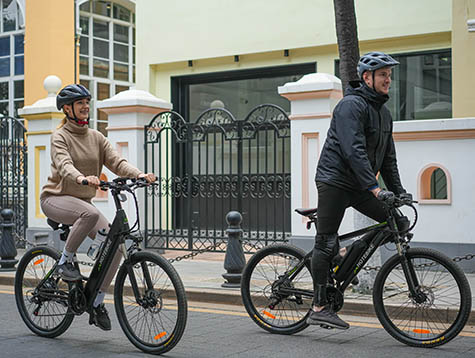Welcome to our comprehensive guide on how to ride an electric bike! Whether you’re a beginner or simply looking to brush up on your skills, this article will provide you with all the information you need to confidently hop on an e-bike and start enjoying the benefits of eco-friendly transportation. We’ll cover everything from the basics of operating an electric bike to safety tips and recommended gear. So, let’s dive in and discover the world of electric biking!

Getting Started with Electric Bikes
An electric bike, also known as an e-bike, is a bicycle that is equipped with an electric motor to provide propulsion. It combines the traditional features of a bicycle with the assistance of an electric motor, allowing riders to pedal with less effort and travel at higher speeds.
Electric bikes come in various designs, including mountain bikes, road bikes, city bikes, and folding bikes, among others. The electric motor is typically powered by a rechargeable battery that is mounted on the frame of the bike. The motor provides assistance to the rider when pedaling, making it easier to tackle hills and ride longer distances.
Most electric bikes have different modes or levels of assistance, allowing riders to choose the amount of electric power they want to use. Some e-bikes come with a throttle, which allows riders to engage the motor without pedaling, while others require pedaling to activate the motor.
Electric bikes have gained popularity due to their numerous advantages. They provide a more environmentally friendly alternative to traditional vehicles, as they produce zero emissions during operation. E-bikes also offer health benefits, as riders still engage in physical activity while enjoying the assistance of the electric motor. Additionally, electric bikes can be a cost-effective mode of transportation, saving on fuel costs and reducing the need for car maintenance.
It’s worth noting that regulations regarding electric bikes may vary depending on the country or region. It’s important to familiarize yourself with the local laws and regulations governing the use of electric bikes in your area.
Choosing the Right Electric Bike for You
Choosing the right electric bike for you involves considering several factors based on your needs, preferences, and riding style. Here are some key points to consider:
Intended Use: Determine how you plan to use the electric bike. Are you looking for a bike for commuting, recreational rides, off-road adventures, or a combination of these? Different types of e-bikes are designed for specific purposes, such as city bikes, mountain bikes, road bikes, or hybrid bikes.
Motor Type and Power: Electric bikes come with different motor types, including hub motors (located in the wheel) or mid-drive motors (integrated into the bike’s frame near the pedals). Consider the power output of the motor, commonly measured in watts. Higher wattage generally means more assistance and better performance, especially on challenging terrains.
Battery Range and Capacity: Check the battery’s range, which indicates how far the bike can go on a single charge. Consider your typical riding distance and make sure the e-bike’s range matches your needs. Battery capacity is measured in watt-hours (Wh). A higher watt-hour rating generally means a longer range.
Pedal Assist Levels: Look for an electric bike that offers multiple pedal assist levels. These levels allow you to adjust the amount of assistance provided by the motor. Having different levels enables you to customize your riding experience based on the terrain, your fitness level, or desired workout intensity.
Frame Design and Size: Consider the frame design and size that suits your body type and riding style. Electric bikes come in various frame styles, such as step-through, step-over, or compact folding designs. Choose a frame size that provides a comfortable riding position and proper fit.
Components and Accessories: Check the quality of components such as brakes, gears, suspension, and tires. Ensure they are suitable for the type of riding you plan to do. Additionally, consider any accessories you may need, such as lights, racks, fenders, or a suspension seat post.
Test Ride: Whenever possible, test ride different electric bike models before making a decision. This allows you to assess the bike’s comfort, handling, and performance firsthand. Pay attention to how the bike accelerates, brakes, and handles various terrains.
Budget: Determine your budget range for an electric bike. E-bike prices can vary significantly based on features, motor power, battery capacity, and brand. Find a balance between your budget and the features that are most important to you.

Safety First: Helmet and Protective Gear
Safety is indeed a crucial aspect when riding any type of bike, including electric bikes. Wearing appropriate protective gear, especially a helmet, is vital to ensure your safety on the road. Here are some points to consider regarding helmets and other protective gear:
Helmet: Always wear a properly fitting helmet when riding an electric bike. Choose a helmet specifically designed for cycling and ensure that it meets the safety standards established by your country or region. The helmet should fit snugly on your head and sit level, covering your forehead. It should have adjustable straps to secure it in place. Replace your helmet if it has been involved in a crash or if it shows signs of damage or wear.
Protective Clothing: Consider wearing appropriate protective clothing, especially when riding in more challenging conditions or at higher speeds. This may include:
Padded cycling gloves: They provide grip, protection, and cushioning. They can also protect your hands in the event of a fall.
Cycling-specific shoes: They offer better grip on the pedals and may have stiffer soles for improved power transfer.
Reflective clothing: Wear bright or reflective clothing, especially when riding in low-light conditions, to enhance your visibility to other road users.
Protective eyewear: Consider wearing sunglasses or clear glasses to protect your eyes from wind, dust, insects, or any debris.
Reflective accessories: Attach reflective strips or accessories to your bike or clothing to increase your visibility on the road, especially at night.
Other Safety Equipment: Depending on your riding style and preferences, you may also consider additional safety equipment such as:
Knee and elbow pads: These can provide extra protection in case of a fall or accident, particularly for off-road or more aggressive riding.
High-visibility vests or jackets: These can enhance your visibility, making it easier for other road users to see you.
Rearview mirrors: Attach a mirror to your handlebars or helmet to have a better view of the traffic behind you.
Safe Riding Practices: Beyond protective gear, it’s important to adopt safe riding practices. Observe traffic rules, use hand signals when turning or changing lanes, ride defensively, and be aware of your surroundings. Stay focused, avoid distractions, and maintain a safe distance from other vehicles.
Checking the Battery and Tire Pressure
Regularly checking the battery and tire pressure of your electric bike is important for ensuring optimal performance, safety, and extending the lifespan of your components. Here are some guidelines for checking these aspects:
Battery:
Charging: Follow the manufacturer’s instructions regarding charging your electric bike’s battery. Charge it fully before each ride, especially if you plan to travel longer distances.
Battery health: Periodically check the battery’s health and capacity. Some electric bikes have built-in displays or indicators that show the battery level. If you notice a significant decrease in battery performance or range, it may be time to have the battery checked or replaced by a professional.
Tire Pressure:
Proper inflation: Maintain the recommended tire pressure specified by the manufacturer. This information is usually imprinted on the sidewall of the tire or provided in the bike’s user manual. Underinflated or overinflated tires can affect the bike’s handling, stability, and efficiency.
Check pressure regularly: Use a reliable tire pressure gauge to check the tire pressure. It’s advisable to check the pressure before each ride or at least once a week. Changes in temperature and riding conditions can cause fluctuations in tire pressure.
Inflate as needed: If the tire pressure is below the recommended range, use a bicycle pump with a gauge to inflate the tires to the desired pressure. Avoid overinflating the tires, as it can make the ride uncomfortable and increase the risk of punctures or blowouts.
Remember, different types of electric bikes may have specific battery and tire pressure requirements, so refer to the manufacturer’s guidelines for your particular model.
In addition to battery and tire pressure, it’s also a good practice to regularly inspect your electric bike for any signs of damage, wear, or loose components. This includes checking the brakes, lights, cables, and drivetrain. If you notice any issues or are unsure about maintenance procedures, consult the manufacturer’s instructions or take your bike to a professional bike shop for inspection and servicing.
Adjusting the Seat and Handlebars for Comfort
Adjusting the seat and handlebars of your electric bike to achieve a comfortable riding position is crucial for enjoying your rides and minimizing strain or discomfort. Here are some tips for adjusting the seat and handlebars:
Seat Height:
Start by standing next to your bike and adjusting the seat height to approximately hip level.
Sit on the bike and place your feet on the pedals in a comfortable position.
While pedaling, your leg should have a slight bend at the knee when the pedal is at its lowest position. This ensures proper leg extension and reduces strain.
Adjust the seat height accordingly by loosening the seat clamp and raising or lowering the seat post. Once adjusted, tighten the seat clamp securely.
Seat Position:
The seat can be adjusted forward or backward to find the optimal position.
Sit on the bike and place your feet on the pedals.
Position the pedals parallel to the ground. Place your heels on the pedals and ensure your legs are fully extended.
Adjust the seat position forward or backward to achieve a comfortable knee alignment over the pedals.
Tighten the seat clamp securely after making the adjustment.
Handlebar Height:
Handlebar height affects your riding posture and comfort.
Most electric bikes have an adjustable stem that allows you to raise or lower the handlebars.
Loosen the stem bolts using an appropriate tool. Adjust the stem to the desired height, ensuring it is aligned with the front wheel.
Make sure the stem is securely tightened to avoid any movement or instability while riding.
Handlebar Reach:
Handlebar reach determines how far you need to stretch your arms to reach the handlebars comfortably.
If your handlebars feel too far or too close, you can adjust the reach by changing the stem length or using stem spacers.
Consult your bike’s user manual or seek assistance from a professional bike shop to make these adjustments properly.
Remember to make gradual adjustments to your seat and handlebars, testing each change during a ride to assess comfort and riding posture. Small adjustments can make a significant difference in your riding experience. If you’re unsure or want personalized advice, consider consulting a bike fitting professional who can help you achieve an optimal fit for your electric bike.
After reading it, do you have a deeper understanding of electric bicycles?In conclusion, riding an electric bike is a fantastic way to enhance your commuting experience while reducing your carbon footprint. By following the guidelines and techniques outlined in this guide, you’ll quickly become a confident and skilled e-bike rider. Remember to prioritize safety, stay aware of your surroundings, and enjoy the freedom and convenience that electric biking offers. So, grab your helmet, hop on an electric bike, and embark on your eco-friendly journey today! Happy riding!
 Shuangye ebike
Shuangye ebike
